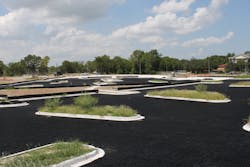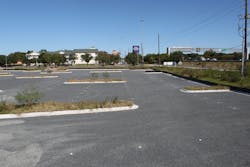The best BMCX (bicycle motorcross) racers in the world will meet at the Rockstar Energy Bike Park in Houston, TX, at the end of May for the UCI BMX World Championships. The eight-month-old park will host participants, spectators, and officials from around the world for the event. Little do the visitors know, the park had a tough time getting through the design and permitting process for the park to meet the stormwater regulations and allow for all the visitors to park in the Greenspoint area of Houston.
In October 2016, Union Cyclist International (UCI) announced that Houston would host the 2020 UCI BMX World Championships at the yet-unfinished park. As a $13–14 million extension of North Houston Skate Park, the largest skate park in North America, the BMX park was designed on 30 acres of the site. North Houston Development Corporation (NHCD)—formerly Greater Greenspoint Redevelopment Authority—a charitable organization of the City of Houston Economic Development Commission, was tasked with the project as they had completed the Skate Park and the land was available adjacent to their former project.
While 30 acres might seem like enough to accommodate a BMX track, the UCI had other requirements set to host the Championships. The facility needed the BMX track, a pump track, street features, an amphitheater, bowls, an events plaza, and office buildings—not to mention enough visitor parking to handle the events. Adding up all those features put pressure on the NHDC and their design teams at OJB Landscape Architects and Walter P. Moore Civil Engineering.
Hard at work and with the experience of the Skate Park behind them, the teams at the design firms came up with a site plan that worked, with all the elements and facilities they needed with a traditional stormwater management approach—several open detention ponds surrounded by concrete parking. However, one problem emerged; there was not enough parking for the expected number of visitors. The City of Houston and UCI needed 100 more parking spaces to meet the capacity requirement.
The OJB was familiar with using permeable paving for stormwater runoff reduction from previous projects and had used them successfully. In discussion with Walter P. Moore (WPM) Engineering, the firms decided that one possibility to solving the parking shortage would be to switch from concrete to permeable paving. Along with the runoff reduction, WPM looked into the stormwater detention capacity of permeable paving systems. One system in particular, PRO PLUS by TRUEGRID, had a 40% void ratio by volume. TRUEGRID PRO PLUS, a plastic grid permeable paver, was selected as the bases for the new parking lot designs.
With the new parking systems in mind, Scott Blons, technical director at OBJ and principal designer on the project, repurposed the two main parking lots—one on the north end and a larger one on the south end—into permeable paving detention systems. The plastic grid pavers were filled with open-graded three-quarter-inch stone at 1.8 inches deep and sit on an 8-inch base course of open-graded 1-inch stone.
At that designed depth, the PRO PLUS paver system has a capacity to store one-third of a cubic foot of water per square foot. The two parking lots can hold more than 63,000 cubic feet of stormwater in the cross-section.
Blons designed in other bioswale detention methods and the park is able to hold over 3,417 cubic yards of water. The parking lot TUREGRID gravel system provides over 68% of that capacity.
With the additional land savings and regained parking spaces, Blons was able to keep several wooded areas intact in his new, improved design. The trees and vegetation added to the park's appeal.
The new parking lot designs maintained much of the character of the original, with vegetated tree islands, curbs, and unique angles. The trees in the islands will be able to thrive—permeable paving allows for oxygen, carbon dioxide, and water transference for healthy roots. Unlike with impermeable surfaces, trees can continue to grow in permeable paving and their roots will not be suffocated.
As for installing the permeable paver parking lot, “Construction went really smoothly,” says Blons. “It was pretty seamless. The TRUEGRID team was on-site to help the contractor with installation.”
One of the most important results of the permeable paver system being installed was the monetary savings to the NHDC. The non-profit corporation saved an estimated one million dollars by utilizing the permeable system versus a traditional concrete parking surface and large detention ponds.
Installation of PRO PLUS is about 75% of the cost of concrete paving with comparable cross-sections. PRO PLUS is also much stronger in compressive strength than concrete; it flexes with soil heaving and freeze-thaw cycles and has a 25-year projected lifespan.
PRO PLUS is a heavy-load bearing, commercial, and industrial-grade grid paver made from 100% recycled post-consumer high-density polyethylene plastic. One unit of PRO PLUS is 24 inches by 24 inches and 1.8 inches high. Each unit interconnects to adjacent pieces with three-point locking tabs. PRO PLUS is self-anchoring when filled up to 20-degree slopes.
The base course design for the PRO PLUS system consists of a non-woven spun-bonded geotextile fabric over the proof-rolled subgrade and 8 inches of 3/4 inch clean limestone. The wearing course consisted of the TRUEGRID PRO PLUS grids and 1.8 inches of fill material consisting of 5/8-inch Blackstar, a basalt gravel. The entire cross-section has a 40% void ratio for stormwater detention. Parking spaces were delineated by using white SuperSpot parking marker from TRUEGRID. SuperSpots are cylindrical shaped disks with domed tops and are placed inside the recess portion of the PRO PLUS cylinders. The parking markers are high-strength and the dome portion is raised a little less than an inch above the grid and gravel layer for visibility.
Permeable pavers, including TRUEGRID PRO PLUS, have their own natural stormwater filtration and pollution removal abilities through bioremediation. This self-performing filtration added to the savings for the project by removing pumps, filters, grates, and other conveyance items needed by the original design.
Martin Murdoch, P.E. at Jones and Carter, working as the program and construction manager and owner's representative for the NHDC, says, “This definitely kept the cost down. People look at it as a more sustainable site by reducing the amount of pavement.”
There are still several small detention ponds remaining on-site, although these are not necessarily for stormwater detention. “We couldn’t fully eliminate the detention ponds. They are there to cut the amount of fill material used and we needed a net-zero gain on imported material,” continues Murdock. “The site was in a flood plain and there are restrictions on how much soil could be brought in and used.”
“Several large rain events have happened since installation and there’s never been an issue. It’s held up well,” says Murdoch.
One specific isolated incident, during construction, was the Hurricane Harvey flood in August of 2017. Floods hit Houston and the surrounding counties with over 33 inches of rain and there was anywhere from 6 to 12 inches of standing water in the parking lot. The TRUEGRID had yet to be held down with stone fill. After the water receded, some minor adjusting of the grid was needed to reposition it into the complex parking design. This didn’t cause any major delays in the construction schedule according to Murdoch.
The Grand Opening of the park was in August 2019, and the park is now ready for the 2020 UCI BMX World Championships this May. As guests arrive at the park, they won’t know the challenges that went in to meeting stormwater regulations and reducing runoff while providing adequate parking. Excited to see the best BMX athletes in the world compete, they likely won’t pay much attention to the parking lot at all. And that’s just as it should be.
Dustin Glist
Dustin Glist is senior business developer for TRUEGRID Pavers. Glist has 21 years of experience in the stormwater management industry, including with permeable paving, stormwater detention systems, erosion control, drainage, and surfacing materials.











